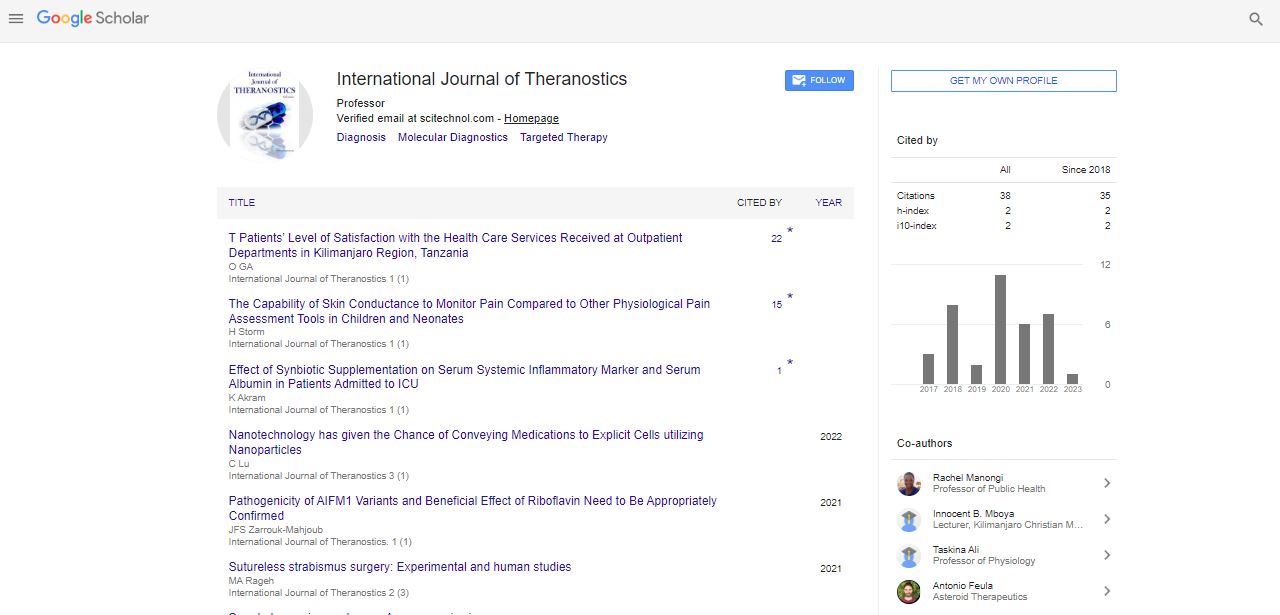Commentary, Int J Theranostic Vol: 12 Issue: 3
CRISPR-Cas9 Theranostics: Shaping the Future of Targeted Gene Modification
Andreas Shin*
1Department of Technical, Institute for Technical and Macromolecular Chemistry, Aachen University, Aachen, Germany
*Corresponding Author: Andreas Shin,
Department of Technical, Institute for
Technical and Macromolecular Chemistry, Aachen University, Aachen, Germany
E-mail: Shinandreas87@gmail.com
Received date: 27 November, 2023, Manuscript No. IJT-23-124064;
Editor assigned date: 29 November, 2023, PreQC No. IJT-23-124064 (PQ);
Reviewed date: 14 December, 2023, QC No. IJT-23-124064;
Revised date: 21 December, 2023, Manuscript No. IJT-23-124064 (R);
Published date: 28 December, 2023, DOI: 10.4172/IJT.1000146.
Citation: Shin A (2023) CRISPR-Cas9 Theranostics: Shaping the Future of Targeted Gene Modification. Int J Theranostic 12:5.
Description
The advent of gene editing technologies has revolutionized the field of molecular biology, offering unprecedented precision and efficiency in manipulating genetic material. Among these technologies, CRISPRCas9 stands out as a powerful tool that has rapidly gained prominence in theranostics-the integration of diagnostics and therapeutics for targeted gene modification and therapy. This essay explores the applications of CRISPR-Cas9 in theranostics, highlighting its potential for revolutionizing medicine by enabling precise genetic modifications to address various diseases.
Clustered Regularly Interspaced Short Palindromic Repeats (CRISPR) and CRISPR-associated protein 9 (Cas9) together form a groundbreaking gene editing system. Originally a part of the bacterial immune system, researchers harnessed CRISPR-Cas9 to selectively modify genes in a variety of organisms, including humans. The system consists of guide RNA (gRNA) that guides the Cas9 protein to the target DNA sequence, where it induces a double-strand break. The cell's natural repair mechanisms then come into play, allowing for gene knockout, replacement, or insertion.
Theranostics represents a paradigm shift in medical practice by combining diagnostics and therapy to create personalized and targeted approaches for patient care. The integration of gene editing technologies, particularly CRISPR-Cas9, enhances the potential of theranostics by enabling precise modification of the patient's genetic material based on diagnostic information. This synergy allows for the development of tailored therapeutic interventions that address the underlying genetic causes of diseases. One of the most promising applications of CRISPR-Cas9 in theranostics is the treatment of genetic disorders. In cases where a single gene mutation leads to a debilitating condition, such as sickle cell anemia or cystic fibrosis, CRISPR-Cas9 offers a targeted approach to correct the underlying genetic defect. By using patient-specific diagnostic information, researchers can design personalized gRNAs to edit the defective gene, potentially curing the genetic disorder at its root.
CRISPR-Cas9 has shown significant promise in the field of cancer theranostics. The ability to precisely edit cancer-related genes allows for the development of targeted therapies that selectively eliminate cancer cells while sparing normal cells. Moreover, CRISPR-based diagnostic tools can be employed to identify specific genetic markers associated with different cancer types, enabling early detection and personalized treatment strategies. The integration of diagnostics and therapy in cancer care through CRISPR-Cas9 heralds a new era in precision oncology.
The ongoing threat of infectious diseases, including viral infections, has prompted researchers to explore CRISPR-Cas9 for theranostic applications. By targeting host susceptibility genes or viral genomes, scientists aim to enhance the host's immunity against infectious agents. CRISPR-Cas9 can be employed to modify genes related to immune response, providing a potential means to confer resistance to specific pathogens. Additionally, the technology facilitates the development of rapid and precise diagnostic tools for infectious diseases, allowing for early intervention and containment.
CRISPR-Cas9 holds immense potential in addressing neurological disorders by allowing researchers to delve into the intricacies of the brain's genetic landscape. The precise modification of genes associated with conditions like Alzheimer's or Parkinson's disease enables a better understanding of the underlying mechanisms. Theranostics in neurology involves not only targeted gene therapy but also the development of diagnostic tools to identify genetic markers associated with neurological disorders, paving the way for early intervention and personalized treatment strategies.
While the applications of CRISPR-Cas9 in theranostics offer unprecedented opportunities, ethical considerations and challenges cannot be ignored. The prospect of editing the human germline raises ethical dilemmas related to the potential for unintended consequences and the creation of "designer babies." Additionally, the off-target effects of CRISPR-Cas9 pose a significant challenge, requiring ongoing research to enhance the system's specificity and safety.
Conclusion
In conclusion, the applications of gene editing technologies, especially CRISPR-Cas9, in theranostics represent a innovative frontier in medicine. The ability to precisely modify genes based on diagnostic information holds tremendous potential for treating genetic disorders, cancers, infectious diseases, and neurological conditions. The integration of diagnostics and therapy through CRISPR-Cas9 not only enhances the precision of medical interventions but also opens new avenues for personalized medicine. As research continues to advance, addressing ethical considerations and refining the technology's safety profile will be crucial to unlocking the full potential of CRISPR-Cas9 in reshaping the landscape of healthcare. The theranostic era is upon us, offering a glimpse into a future where medicine is not just reactive but proactive, targeting diseases at their genetic roots.
 Spanish
Spanish  Chinese
Chinese  Russian
Russian  German
German  French
French  Japanese
Japanese  Portuguese
Portuguese  Hindi
Hindi 